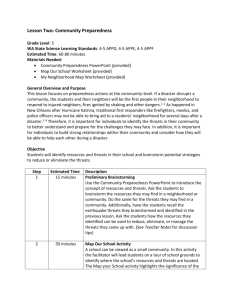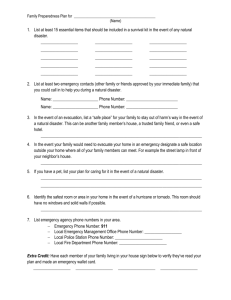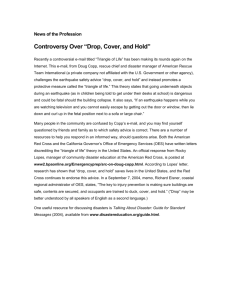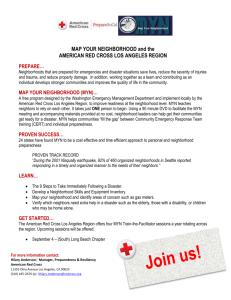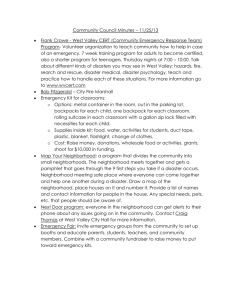Lesson Two: Community Preparedness
advertisement
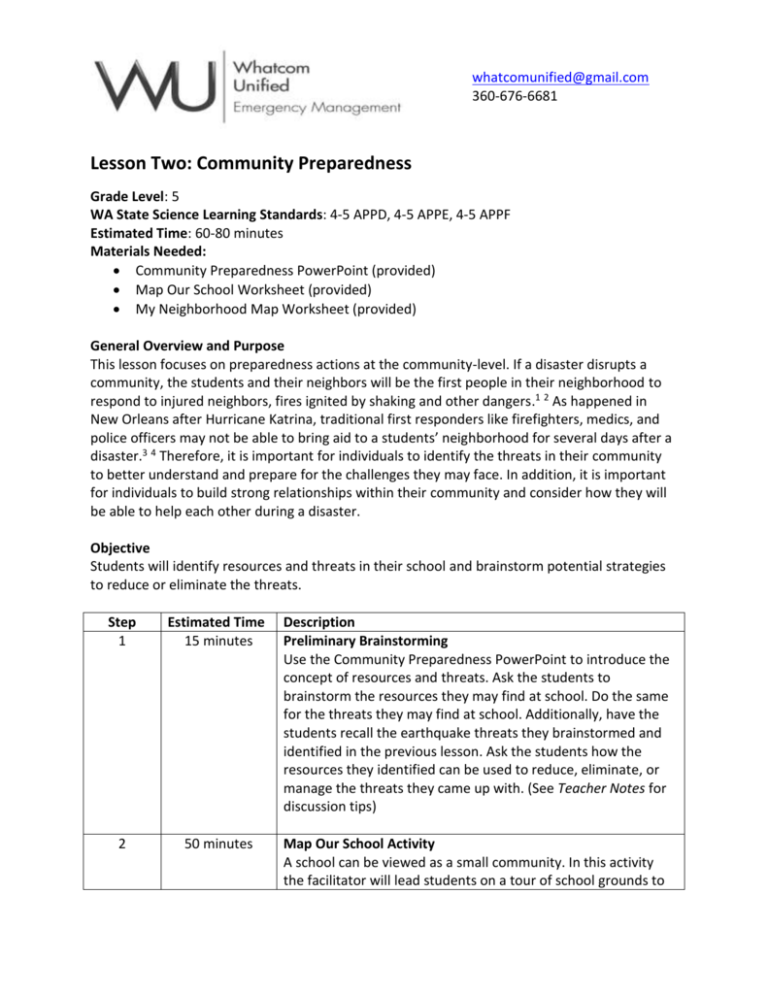
whatcomunified@gmail.com 360-676-6681 Lesson Two: Community Preparedness Grade Level: 5 WA State Science Learning Standards: 4-5 APPD, 4-5 APPE, 4-5 APPF Estimated Time: 60-80 minutes Materials Needed: Community Preparedness PowerPoint (provided) Map Our School Worksheet (provided) My Neighborhood Map Worksheet (provided) General Overview and Purpose This lesson focuses on preparedness actions at the community-level. If a disaster disrupts a community, the students and their neighbors will be the first people in their neighborhood to respond to injured neighbors, fires ignited by shaking and other dangers.1 2 As happened in New Orleans after Hurricane Katrina, traditional first responders like firefighters, medics, and police officers may not be able to bring aid to a students’ neighborhood for several days after a disaster.3 4 Therefore, it is important for individuals to identify the threats in their community to better understand and prepare for the challenges they may face. In addition, it is important for individuals to build strong relationships within their community and consider how they will be able to help each other during a disaster. Objective Students will identify resources and threats in their school and brainstorm potential strategies to reduce or eliminate the threats. Step 1 Estimated Time 15 minutes Description Preliminary Brainstorming Use the Community Preparedness PowerPoint to introduce the concept of resources and threats. Ask the students to brainstorm the resources they may find at school. Do the same for the threats they may find at school. Additionally, have the students recall the earthquake threats they brainstormed and identified in the previous lesson. Ask the students how the resources they identified can be used to reduce, eliminate, or manage the threats they came up with. (See Teacher Notes for discussion tips) 2 50 minutes Map Our School Activity A school can be viewed as a small community. In this activity the facilitator will lead students on a tour of school grounds to whatcomunified@gmail.com 360-676-6681 identify where the school’s resources and threats are located. The Map Our School activity highlights the significance of the resources located on school grounds and demonstrates how these resources can be used to reduce, eliminate, or manage potential threats. 3 15 minutes Debriefing Ask the students what they thought about the activity. Did anything surprise them? Highlight the important skills the students may have. Refer to the Teacher Notes for examples of skills and discussion ideas. Have the students list their own skills a sheet of paper. Generate one large list titled “Our Class’s Skills” to post in the classroom. If more than one student possesses each skill, put tally marks next to the repeated skill. Supplemental Homework Assignment: My Neighborhood Map In the homework assignment the students will create a resource and threat map. A resource and threat map is a drawing of a community showing the important buildings and roads along with the community’s resources and potential dangers.5 6 See the Community Preparedness PowerPoint for examples of resource and threat maps and the Teacher Notes for detailed explanations. whatcomunified@gmail.com 360-676-6681 Teacher Notes Vocabulary Resource: A person, place, or thing that can be helpful to you.7 Threat: Anything that has the potential to cause harm or damage.8 The words “risk” or can be used in place of “threat” in this lesson. Regardless of which word is chosen, it is beneficial to tell the students the words are synonyms. ______________________________________________________________________________ Step 1: Preliminary Brainstorming Use the Community Preparedness PowerPoint to introduce the concepts of resources and threats. Use the notes in the PowerPoint to prompt student input and discussion. Guide the discussion toward resources found on school grounds (PowerPoint Slide 12). Particularly focus on the skills and school’s staff training useful in a disaster. Similarly, encourage the students to brainstorm dangers visible on school grounds. Remind the students of the earthquake threats they identified in the previous lesson. Record the resources and threats they come up with in two separate columns on the board. Suggested questions to stimulate discussion: What types of resources do we have here at school? What types of skills would be useful in a disaster? Who has these skills at our school? What could potentially injure someone at school? What types of dangers could an earthquake cause at school? Examples of resources/skills: 9 10 Water Food First aid supplies Generators (temporary electricity for heat, running water, cooking etc.) CPR or first aid skills Effective communication skills Radio operators (to communicate with other schools or emergency responders if telephone lines are overloaded or disrupted) Leadership skills (direct people to safety) Those who can prepare basic meals for a large group of people Those who can clean up hazardous materials Message deliverers Those who can look after younger children or the elderly Those who can entertain others Those who can suppress fire whatcomunified@gmail.com 360-676-6681 Those who maintain school grounds Examples of earthquake dangers:11 12 Broken glass - windows, lights, pictures (could fall or pierce a student during or after an earthquake) Unsecured furniture (could fall on a student during or after an earthquake) Projectors (could fall or a student during or after an earthquake) High voltage power lines (could electrocute or fall on a student during or after an earthquake) Streetlights (could fall on a student or potentially electrocute during or after an earthquake) Utility wires – telephone, cable, electricity (could fall on or electrocute a student during or after an earthquake) Water mains running under or near the school (if water mains are damaged, limited access to potable water) Gas stations or industries with potentially explosive materials nearby (fires) Parapets (could fall on a student during or after an earthquake) Speakers (could fall on a student during or after an earthquake) Strategizing Instruct the students to brainstorm how the resources the students identified can be used to reduce, eliminate, manage, or adapt to the dangers they identified. This part of the activity is intended to stimulate creativity and innovation. Below are a few examples of ways to use resources to reduce, eliminate, manage, or adapt to threats. Examples: A school or community center can be used as a shelter during a flood or a tsunami. If someone was injured, a student or staff member can provide first aid. Individuals with leadership and communication skills can instruct people to safety. If the power was out, and water no longer came out of the tap, river or lake water can be filtered and used as a temporary water source. Stop the Community Preparedness PowerPoint at Slide 12 and proceed to Map Our School Activity. Step 2: Map Our School Activity Lead the students on a walking tour around the school grounds. Have the students bring along the list of resources and dangers the class brainstormed. Instruct them to record the resources and dangers they identify in their notebooks as well as the location where they find them. whatcomunified@gmail.com 360-676-6681 Have the students’ interview staff members about their skills along the route (skills are an important resource). Provide each student with the worksheet of sample questions and a checklist of the skills they may come across on the tour. (See Teacher Notes) When the tour is complete, post a large piece of paper on the board. As a class, create a map of the school identifying where the resources and dangers are located. Use symbols to describe the resources and dangers on their maps and include a legend. Adapted from IFC, 2010 Step 3: Debriefing Ask the students if any aspect of the lesson stands out to them. Did the amount of resources communities have surprise them? In order to demonstrate students are resources themselves, ask strategic questions about the skills they have. Have you ever babysat or watched over younger siblings? Do you know how to prepare basic meals like sandwiches? Have you ever taken care of a neighbors pet while they were out of town? Have you taken a first aid babysitting course? Have you ever helped a friend when they got hurt? Have you ever told a joke or a funny story to someone who wasn’t feeling well? Examples of student skills:13 14 Look after younger children Take care of pets Prepare basic meals Assist in gathering supplies Deliver messages Identify hazards at home and at school Move heavy objects to lower shelves Rearrange bedrooms to make them earthquake safe Encourage their families to prepare Perform basic first aid Entertain others during a stressful event (e.g. funny stories, jokes etc.) After discussing the skills the students have, go to slide 13 of the Community Preparedness PowerPoint presentation. Explain to the students their skills will be helpful in a disaster and they too are valuable resources to their communities. Suggested dialog is included below and on slide 13. whatcomunified@gmail.com 360-676-6681 Have the students list their own skills a sheet of paper. Generate one large list titled “Our Class’s Skills” to post in the classroom. If more than one student possesses each skill, put tally marks next to the repeated skill. Suggested Dialog: “You may not realize it, but the tasks you perform in your everyday life are incredibly useful in disasters. Watching after younger siblings, taking care of pets, and preparing meals are just a few of the contributions you can make to your community during a disaster. Additionally, you have the skills to prepare for earthquakes by moving heavy items to lower shelves, rearranging your bedroom, and encouraging your parents to prepare.” Supplemental Homework Assignment Provide the students with the My Neighborhood Map Worksheet. Instruct the students to map the important buildings (neighbor’s homes, community centers, schools etc.), roads and physical features, in their neighborhood. Examples of physical features include rivers, hills, valleys, lakes, etc. Encourage the students to map and refer the neighbors in their immediate vicinity by name. Have the students identify and map the resources and dangers in their neighborhood. Encourage the students to use symbols to describe the resources and dangers on their maps and include a legend. Require the students to list their skills and resources on the map next to their household as well as their neighbor’s skills and resources next to their respective household. BONUS: Have the students encourage their parents to hold a neighborhood potluck or gathering where the student can present the map they have created and discuss preparedness in their neighborhood. o If the students elect to take this step, direct them to the Map Your Neighborhood material to guide the discussion on neighborhood preparedness. (See Appendix D) Adapted from UNICEF and UNISDR, 2004 Map Your Neighborhood (MYN) material: Link to MYN webpage: http://www.emd.wa.gov/myn/index.shtml On this page you will find an introduction to MYN, tips for how to organize a MYN team, MYN resources, and other useful information regarding neighborhood preparedness. whatcomunified@gmail.com 360-676-6681 Community Resource and Threat Mapping Around the World (For facilitator reference) The organization Save the Children hosts a disaster-training workshop in seven different Vietnamese provinces. Within the program, children and local community members lead resource and threat assessments and develop emergency preparedness and response plans. Child-led assessments have raised awareness to areas in need of mitigation, which have resulted in great improvements to their communities.15 In El Salvador, Plan International has facilitated youth participation in disaster risk reduction activities within their communities. One of the activities the students participated in was community resource and threat mapping. As a result of this initiative, 50 schools have devised resource and threat maps and are implementing their own disaster plans to address the threats they identified in their communities.16 whatcomunified@gmail.com 360-676-6681 References 1 Petal, M. (2009). Urban disaster mitigation and preparedness: The 1999 Kocaeli earthquake. (Dissertation). (p.110, Table 29 and p.319 and p.68) 2 Ripley, A. (2009). The unthinkable. New York: Three Rivers Press. (p. xi) 3 Sommers, S. (2005). Katrina: Did federal priorities lead to a slow response? International Journal of Mass Emergencies and Disasters, 23(3), 215-219. Retrieved from http://www.ijmed.org/articles/375/ (p.215) 4 Petal, M. (2009). Urban disaster mitigation and preparedness: The 1999 Kocaeli earthquake. (Dissertation). (p. 68) 5 UNISDR & UNICEF (2004). Let’s learn to prevent disasters! Fun ways for kids to join in risk reduction. Retrieved from website: http://www.unisdr.org/2004/campaign/bookleteng/Booklet-english.pdf (p.14) 6 Save the Children. (2007). Training manual child-led disaster risk reduction on schools and communities. Retrieved from http://seap.savethechildren.se/South_East_Asia/Publications/Disaster-risk-reduction/ (p.27) 7 UNISDR & UNICEF, (2004). Let’s learn to prevent disasters! Fun ways for kids to join in risk reduction. Retrieved from website: http://www.unisdr.org/2004/campaign/bookleteng/Booklet-english.pdf (p.14) 8 Merriam Webster. (2012). Dictionary. Retrieved from http://www.merriamwebster.com/dictionary/threat 9 International Finance Corporation. (2010). Disaster and emergency preparedness: Activity guide for k to 6th grade teachers. (p. 6) 10 UNISDR & UNICEF, (2004). Let’s learn to prevent disasters! Fun ways for kids to join in risk reduction. Retrieved from website: http://www.unisdr.org/2004/campaign/bookleteng/Booklet-english.pdf (p.14-15) (NOTE: The sources for 15 and 16 contain similar resources to those mentioned above) 11 Scientists of the U.S. Geological Survey. (1994). The magnitude of the 6.7 Northridge, California, earthquake of 17 January 1994. Science, 226(5184), 389-397. Retrieved from http://www.jstor.org/stable/pdfplus/2885318.pdf (p.395) 12 Petal, M. (2009). Urban disaster mitigation and preparedness: The 1999 Kocaeli earthquake. (Dissertation). (p. 244-245) whatcomunified@gmail.com 360-676-6681 (NOTE: The sources for 17 and 18 provide general descriptions of earthquake dangers and similar examples to those listed above) 13 UNICEF. UNICEF EAPRO, East Asia and Pacific Regional Office. (2007). The participation of children and young people in emergencies. Retrieved from website: http://www.unicef.org/eapro/the_participation_of_children_and_young_people_in_emergenci es.pdf (p. 10, Box 3) 14 Anderson, W. (2005). Bringing children into focus on the social science disaster research agenda. International Journal of Mass Emergencies and Disasters, 23(3), 159-175. Retrieved from http://www.ijmed.org/articles/376/download/ (p. 170-171) (NOTE: The sources for 19 and 20 contain similar student skills to those listed above.) 15 Chen, J., & Thompstone, G. (2005). Children and young people responding to the tsunami. Retrieved from http://www.preventionweb.net/english/professional/publications/v.php?id=2043 (p. 42-43) 16 UNISDR. (2007). Building disaster resilient communities. Retrieved from http://www.unisdr.org/we/inform/publications/596 (p. 12-14)

